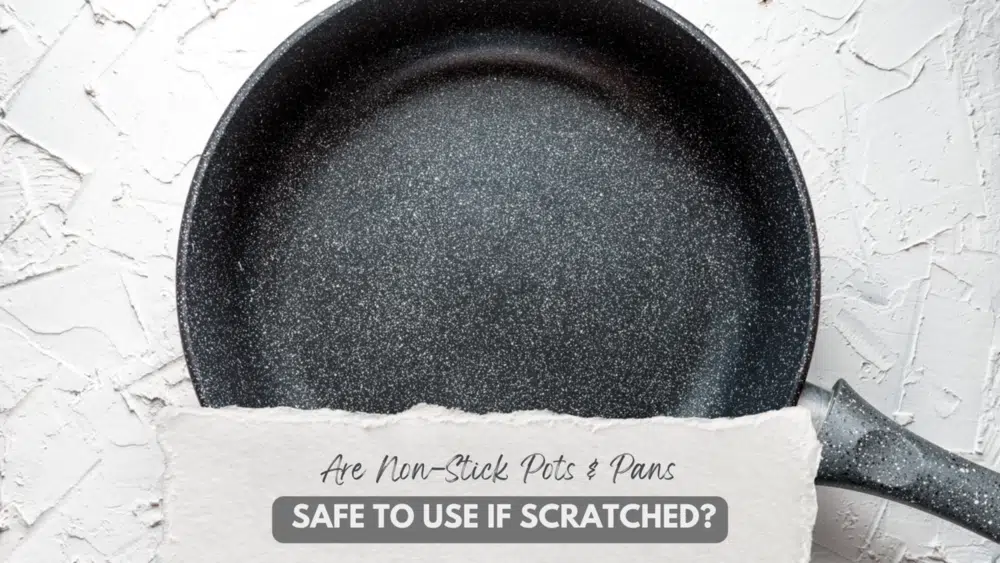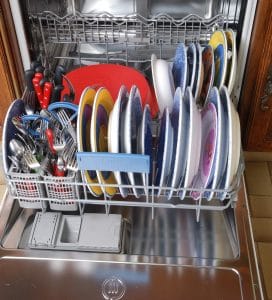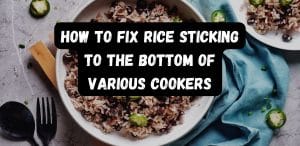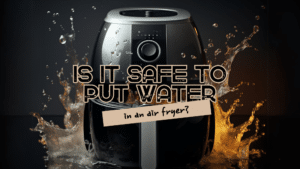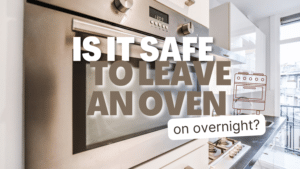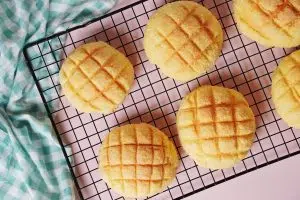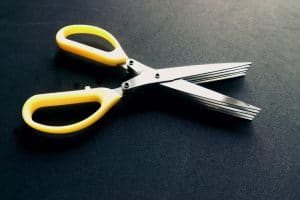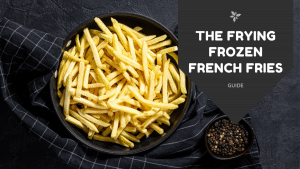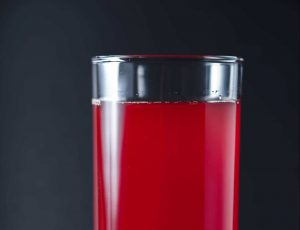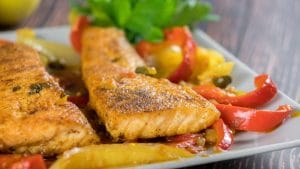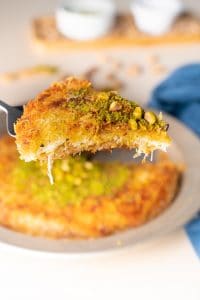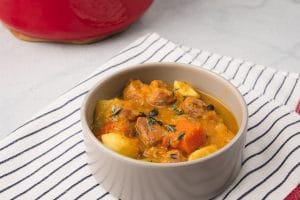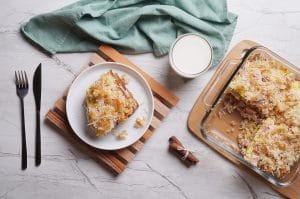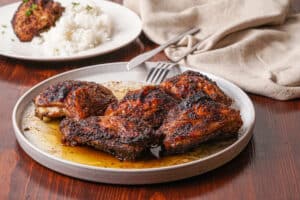Are Non-Stick Pots & Pans Safe To Use If Scratched?
Important Note: When you buy through our links, we may earn a commission. As an Amazon Associate we earn from qualifying purchases. Content, pricing, offers and availability are subject to change at any time - more info.
Key Takeaways
- Unless you’ve really got nothing else to cook in, rather toss a scratched non-stick pot or pan away instead of running the risk of ingesting some of the coating or inhaling its fumes. You won’t suffer any immediate discomfort, nor are there toxic compounds present in modern non-stick coatings, but no one knows exactly what the long-term effects of eating PTFE could be. After all, it took just over 15 years of legal battles to deal with the threat posed by carcinogenic C8 that was present in old coatings for over sixty years (prior to 2013).
- If there’s no other way to prepare your meal or you’re cooking something quick and are willing to live with most likely having eaten Teflon or some other substance, there’s no major danger to using a scratched non-stick pot or pan. Just don’t use the pan at too high of a temperature, and don’t allow the pan to stand atop high heat for too long, or the PTFE will start outgassing. No dry frying either, or the excessive heat will vaporize what’s left on your cookware’s coating into toxic fumes in no time.
After a certain degree of use, non-stick pots and pans will eventually begin to develop scratches, no matter how careful you may have been. Wear and tear will take its toll on even the best brands. Scratched, peeling, non-stick coating immediately raises concerns, and rightfully so. Our guide on whether non-stick pans are safe to use if scratched will show you exactly how to tell the degree of damage while explaining all the risks to be aware of and how to avoid them.
Is It Safe To Use Scratched Non-Stick Cookware?
Even though the risks are minor and a handful of uses will probably never produce noticeable negative effects, using scratched non-stick pots and pans is not safe. You’ll most likely be eating trace elements of the coating itself, and if not the coating directly, the chemicals leached by the food when toxic off-gassing starts. To understand the dangers, let’s take a look at what non-stick are made of and what happens when they’re heated.
What Happens When Scratched Non-Stick Surfaces Are Heated?
Regardless of which type of PTFE coating is used, when non-stick pots and pans are heated beyond 500°F (260 °C), they begin intermittently releasing fumes that are growing in strength. At between 572°F and 842°F (the highest heat possible with a conventional stove top, oven, or range), the pot or pan will be emitting hazardous levels of invisible, odorless polymer fumes as the coating is quite literally burned away.
The Difference Between Old Non-Stick & New Technologies
Polytetrafluoroethylene or PTFE coating was invented in 1938 by an employee of the same company that still owns Teflon, DuPont. The formula for PTFE-based non-stick coatings largely remained the same across all manufacturers up until 2013, when Teflon changed its composition and officially became free of perfluorooctanoic acid (PFOA). PFOA was widely used in non-stick coating up until global communities became aware of its toxicity and carcinogenic nature.
PFOA became commonly known as C8 due to its eight-carbon chain structure that grants it remarkable versatility as a surfectant. Perfluorooctanoic acid (PFOA) and perfluorooctane sulfonate (PFOS) are synthetic chemicals that are known as perfluoroalkyl and polyfluoroalkyl substances (PFAS). PFAS are used across countless different industries, and both PFOA and PFOS are confirmed as potentially carcinogenic by the International Agency for Research on Cancer Fortunately, you won’t find PFAS in any food-based industry’s applications in the US and most of the EU.
With this in mind, shoppers should be aware that only the brand Teflon and manufacturers in prohibited countries changed their non-stick coating. Other companies haven’t necessarily updated their manufacturing to lower customer risk, especially in countries outside of the US and Europe. The 2010/2015 PFOA Stewardship Program encouraged companies to phase out PFOA and perfluorooctane sulfonic acid (PFOS). The phasing out of PFOA by the primary manufacturer, the 3M Company, started in 2002. By 2016, both PFOA and PFOS became prohibited in food contact applications across America.
Non-Stick Coating Types
There are five main non-stick technologies used across almost all pots and pans in production.
Old C8 PTFE
Although banned across Europe and the United States, in many countries like China, PTFE that still contains PFOA, otherwise known as ‘C8,’ is prevalent. Non-stick pots and pans manufactured before 2015 may still contain the cancer-causing perfluorinated carboxylic acid. You’ll typically also find PFOA-based non-stick cookware available across the cheaper brands in third-world countries and stores that sell ‘gray’ imports or goods intended for resale in countries other than the place they’re being sold.
Current PFOA-Free PTFE
In the US, Europe, and many other countries, all PTFE-based applications are PFOA-free. This includes the most famous brand, Teflon, which was one of the first to switch. Eating flaking, peeling Teflon, or any other PTFE coating manufactured after 2015 will do nothing more than upset your stomach, if anything, as it passes through your system. There is no cancer risk, and no other long-term symptoms are known.
Anodized Aluminium
Anodized aluminum is a safer alternative to conventional coated non-stick cookware. What makes this durable cookware different is that the base has been hard-anodized, which makes it unable to leach chemicals into food or react with acidic ingredients like vinegar and tomatoes. Not all anodized aluminum pots and pans are coated with a non-stick PTFE coating, but almost all are. When a non-stick hard anodized aluminum pot or pan coat starts losing its coating, the exact same risks prevail as with regular non-stick cookware, just at lesser concentrations of the fumes produced and PTFE flakes lost.
Silica
While a relatively new application, certain manufacturers have begun using colloidal silica to form a non-stick coating that resembles a ceramic surface. In the minute levels that would be leached in the case of scratches forming, silica is non-toxic to consume. It is also safe to inhale as long as it’s not in its raw crystalline form, which it isn’t in the case of silica-coated non-stick cookware. While relatively safer than other builds, we’d still say replace your pot or pan as soon as you see signs of damage.
Enameled/Ceramic
Chipped enameled cookware shouldn’t really continue to be used as the cast iron, or carbon steel beneath is exposed. Most manufacturers will advise you to replace the pot or pan immediately upon noticing a chip or cracking. If you have to continue using scratched, cracked, or chipped ceramic cookware, ensure that you season the exposed area with a little cooking oil after each bout of cleaning. Furthermore, if you own a high-end brand like La Creuset, it’s probably covered for a replacement so check in with your supplier.
The Risks of Using Scratched Pots & Pans
Eating the coating and inhaling the fumes are the two biggest worries when using a scratched non-stick pot or pan. Let’s take a closer look.
Consuming Non-Stick Coatings
When you notice a scratch on your non-stick coating, it’s only a matter of time before the rest comes off. PTFE The major problem with consuming even the smallest quantity of PFOA found in old non-stick cookware is that it literally stays in your body forever. With quality cookware that’s PFOA-free like all present-day Teflon, even if you do end up eating flakes of non-stick polymer, it’ll just pass through your system within a matter of days. There is no significant risk.
Teflon Flu
Any temperature higher than 500°F will cause PTFE to start releasing toxic fumes. When one is overexposed, polymer fume fever which is also known as fluoropolymer fever or simply ‘Teflon Flu’ or many of its acute symptoms, can occur. Headaches, severe temperature fluctuations, general weakness, coughing, and tightness of the chest that’s similar to angina can all be felt up to four to eight hours after inhaling PTFE fumes.
Outgassing Toxicity & Pets
As soon as non-stick cookware reaches above 500°F, it starts outgassing regardless of whether or not there are any scratches present. The worse the damage, the more of the coating will burn away into fumes. While polymer fume fever caused by inhaling PTFE fumes can injure the lungs of humans and cause flu-like symptoms, it can kill pets.
Parrots are particularly susceptible, as are other birds and animals who breathe at a rapid rate. Birds can die from PTFE toxicosis in a matter of just a few minutes, whereas rats, mice, hamsters, and other small pets can experience a fatal overdose of fumes in a quarter of an hour flat. To make matters worse, there is no known antidote.
Challenging Cooking Surface That’s The Opposite Of Non-Stick
The only thing worse than an untreated pan that’s being used like its non-stick is partially coated cookware that only gets stuck in certain places. Cooking in a non-stick pot or pan with scratches can be extremely challenging, to say the least. Whipping up certain things like sauces, albeit with the risks considered, will work, whereas other applications like non-stick frying of eggs, bacon, and the like will cook up nothing but frustration.
How To Use Scratched Non-Stick Pots & Pans Safely
If you’re forced to use a non-stick pot or pan that’s incurred a few scratches, first make sure that the coating isn’t flaking or peeling off directly. Give it a good scrub to double-check that you won’t be eating Teflon, and then use it as per usual at anything other than ultra-high temperatures. It’ll be perfectly fine for most quick frying and short-duration stews and sauces but don’t use it to sear. Also, avoid dry frying or frying for long durations, as the higher the heat, the more likely you’re generating PTFE fumes and accumulating non-stick particles in your food.
Identifying Risky Non-Stick Cookware
Don’t be left wondering whether or not your scratched cookware is safe to use. Simply evaluate your non-stick pots and pans using the following criteria.
Low-Quality Cookware
If you paid next to nothing for a pot or pan branded as a non-stick but without any information concerning its origin or the type of coating, then you may just have PTFE inclusive of the now-banned carcinogenic compound, C8. PFOA-free is the only non-stick you should be using, and if you’re not sure, don’t risk it.
Old Cookware
Many different types of old pots and pans, ranging from cast iron to enamel, are fantastic and can very well last a lifetime without incurring the slightest degradation or damage. Non-stick pots and pans are not that type of cookware. For over sixty years, Telfon and other brands of PTFE coating relied on PFOAs, which are, today, a known cancer-causing compound. It’s unlikely that old non-stick cookware could have lasted very long, but if yours has, there’s almost certainly wear and tear, which means it needs immediate replacement.
Severely Scratched Or Peeling Cooking Surface
If you want to be totally safe, toss the pot or pan in question away as soon as you notice the first signs of damage to the coating. The greater the degree of damage, the more PTFE you’re consuming every time you cook, and there’s no telling what the polymer fumes are subtly doing to your lungs and body.
Preventing Damage To Non-Stick Coatings
There are several common causes of damage to non-stick coatings. Here are the prime culprits:
Metal/Non-Non-Stick Utensils – Stick to non-stick utensils only, and you’ll extend the lifespan of your cookware considerably. Don’t miss our wrap-up of the best spatulas for non-stick cookware and be sure to find the best in range for all your other utensils too.
Abrasive Cleaning Aids – All non-stick metal products should always be hand washed in lukewarm water using a non-abrasive sponge and then rinsed carefully afterward.
Harsh Detergents – Mild dishwashing soap is the only suitable cleaner for non-stick pots and pans.
Improper Storage – Take extreme care to avoid packing non-stick cookware underneath other goods, as the coating could easily accrue a knick in no time.
Excessive Heat – Refrain from dry frying for anything more than five to ten seconds at a time in a non-stick pot or pan, and don’t fry at maximum temperature for too long with a sparse amount of ingredients only. Never place non-stick cookware in the oven, as it cannot sustain the heat and will begin to lose its coating.
Even the best-kept pan will eventually need to be retired, so while these tips will help, they won’t extend the lifespan of your cookware indefinitely.
Frequently Asked Questions – Scratched Non-Stick Pots & Pans
Have you been left wondering anything about scratched non-stick pots and pans? We’ve got all the info you need coming up.
Scratched non-stick pots and pans aren’t necessarily dangerous if the scratches are surface level and the pan isn’t heated to a very high degree. Unless the non-stick coating is literally peeling off, your cookware is probably still safe to use until you find a replacement. Cooking with a badly damaged pot or pan comes with significant risks, so it is vital to know how to assess the level of damage.
PFOA-free non-stick cookware such as today’s Teflon is safe for cooking on a standard stovetop at temperatures that are below 500°F. At this point, the coating begins to break down and form toxic fumes that can be hazardous to humans and lethal to animals.
Modern non-stick pans cannot cause cancer regardless of whether or not they’re scratched. They can flake, and they will fume toxic gasses when used at incorrect temperatures, but they don’t contain any cancer-causing compounds. However, non-stick cookware that relies on PTFE coating, inclusive of PFOA, which is a known carcinogen, can most definitely cause cancer. Old Teflon, such as that which was sold for over sixty years up until 2013, has been connected to kidney cancer, testicular cancer, ulcerative colitis, thyroid disease, hypercholesterolemia (high cholesterol), and pregnancy-induced hypertension.
A pot or pan coated with Teflon has a lifespan of at least three years. PTFE-coated cookware generally lasts anything between three and ten years at the most, with most failures occurring around the five to seven-year mark, according to data from America’s Test Kitchen.
Recoating a non-stick pan is possible, but in the vast majority of cases, it is far too costly. Only the best pans will be eligible for the lengthy recoating process that involves stripping away the PTFE and then reapplying what can be seven or more layers before rebaking at ultra-high temperatures. Teflon and other PTFE pans are disposable by design. Most will not be eligible for recoating, and those that are will often cost as much as a new pot or pan to refurbish. There are, however, certain brands like Circulon and the Ninja Zerostick range, which are likely to last two to three times as long as regular non-stick cookware.
It is extremely difficult to remove the non-stick coating of a pot or pan completely. However, if you have managed to strip the coating and have then sanded down all deep scratches to form a sheer flat surface, then yes, your cookware is still safe to use. The only problem with sanding down a pan, even if one puts all the effort and expense aside, is that the cooking surface will be full of tiny holes as all non-stick cookware is abrasively blasted to a mottled texture before coating.
Technically inclined DIYers looking to strip down away their non-stick layers completely should consider either sandblasting, dipping in a strong acid or aluminum oxide, or scrubbing it away with an electric wire brush. Regardless of which method is used, a lengthy session in an oven at high heat should follow to burn away any coating that may be left over. Just be sure to do this far from animals and with adequate ventilation in the room.
